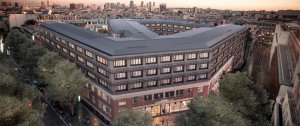Molecular force balance allows the prediction of wall thickness of mesoporous materials
Since the discovery of mesoporous materials using micelle templates two decades ago, the booming of this field has been impressive. This kind of synthesis has been developed for diverse applications as catalysis, sensing, separation and much kind of oxides (silica, titania, zirconia). This synthesis is based on the layout of semi-rigid cylinders of surfactant in a water-phase solution. These self assembled surfactant acts as template during the sol gel process which occurs in the space left between the cylinders. Next, the wet dispersion of precursor material in the surfactant solution is aged, washed and finally calcined to remove the template. The control of surfactant geometrical parameters during the inorganic polymerisation impacts directly the properties of the final mesoporous materials. For example, the diameter of templating cylinder controls the final pore size. Nevertheless, in spite of several experiment attempts to control wall thickness, any clear and unquestionable explanation is not yet available. In this way, we develop a simple analytical model which predicts variations of wall thickness through experimental conditions. This model is free parameter and is in great agreement with experimental data available from the literature for the case of hexagonal array of cylindrical pores. The model concept consists of three main uncoupled driving forces : repulsive electrostatic, repulsive hydration and attractive Van der Waals. By adding all these supramolecular interactions and searching a minimum in potential, this latter gives then the equilibrium distance value between surfactant cylinder and consequently an expected wall thickness. The confrontation of our model with experimental data is illustrated here by several examples in order to better understand the wall thickness variation with the experimental process. This simple analytical model based on molecular force balance proposed here explains qualitatively and quantitatively in some simple cases, the wall thickness of silica-based mesoporous materials obtained via the sol-gel route.
ICSM Laboratoire de nanomatériaux auto-réparants, CEA Marcoule
La liste des séminaires du laboratoire peut être consultée sur le lien : http://www.ppmd.espci.fr/
Contact : antoine.chateauminois@espci.fr








